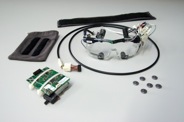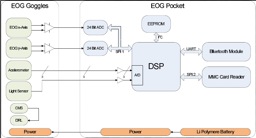The wearable eye tracker (“EOG Goggles”) offers a novel technology to robustly record eye movements during physical activities in daily life, relying on (EOG) signals captured by pairs of electrodes attached to goggles and placed around one eye.
Organization: ETH Zurich, Switzerland
Inventor: A. Bulling, ETH Zurich, Switzerland
Primary Market: Health & Medical Devices, Personal Care, Elderly Care
Technology Contact: M. Kraake, ETH Zurich, Switzerland
IP Overview Courtesy of ETH Zurich, Switzerland
The invention is a wearable eye tracker based on electrooculography (EOG) which implements electronics and dry electrodes attached to a glasses frame. The eye tracker is robust to simultaneous physical activities and applicable in many different fields.

EOG Goggles with dry electrodes to capture the signals around the eyes and body-worn device for real-time signal processing and artifact compensation during by physical activity.

block diagram of the system
Andreas Bulling invented the technology at the Wearable Computing Laboratory of Prof. G. Tröster, ETH Zurich (Switzerland). “We are looking for a partner in the field of medical diagnostics or novel human-computer and game interfaces to market the technology and jointly bring it to the next level in order to fit it to his particular market needs.”
Available systems in the marketplace mostly rely on CCD sensors and even the most wearable ones still require rather bulky equipment. They also require appropriate light conditions while our sensor system is light-weight and can work in glaring light as well as in complete darkness. Furthermore, the processing required for the CCD sensor signal is quite complex which limits the runtime of these systems. Our EOG-based system only has two one-dimensional input signals: one for each movement component of eye movement (horizontal and vertical). This makes the signal processing much easier and allows for efficient implementation on an embedded device. It features additional sensors, such as a light-sensor and an accelerometer, which are used for artefact compensation. Due to the small size and unobtrusiveness of the system (incorporated in goggles) and the real-time signal processing capabilities, it can be carried around all day. Thus, autonomous long-term eye movement recordings lasting for several hours in mobile daily-life settings become possible.
We propose the following fields of application: